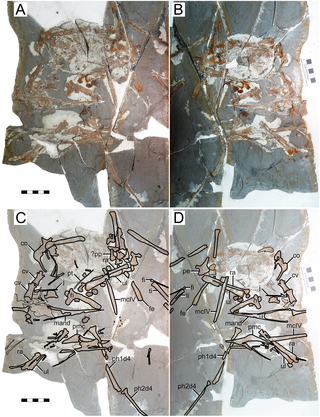
Ordos, also known as Ih Ju, is one of the twelve major subdivisions of Inner Mongolia, China. It lies within the Ordos Plateau of the Yellow River. Although mainly rural, Ordos is administered as a prefecture-level city. Its population was 2,153,638 as of the 2020 census, and its built-up area made up of Ejin Horo Banner and Kangbashi District was home to 366,779 inhabitants, as Dongsheng District is not a conurbation yet.

Sinornithoides is a genus of troodontid theropod dinosaurs containing the single species Sinornithoides youngi. S. youngi lived during the Early Cretaceous. It measured approximately one meter long (3.3 ft). It lived in Inner Mongolia, China, and probably ate invertebrates and other small prey. They lived in what is now Mongolia, which was part of Laurasia.

Eopteranodon is a genus of tapejarid pterosaur from the Aptian-age Lower Cretaceous Yixian Formation of Beipiao City, Liaoning, China. The genus was named in 2005 by paleontologists Lü Junchang and Zhang Xingliao. The type species is Eopteranodon lii.
Eoazhdarcho is a genus of azhdarchoid pterodactyloid pterosaur named in 2005 by Chinese paleontologists Lü Junchang and Ji Qiang. The type and only known species is Eoazhdarcho liaoxiensis. The fossil was found in the Aptian-age Lower Cretaceous Jiufotang Formation of Chaoyang, Liaoning, China.

Pterorhynchus is an extinct genus of pterosaur from the mid-Jurassic aged Daohugou Formation of Inner Mongolia, China.

The Qing dynasty of China ruled over the Mongolian Plateau, including Inner Mongolia and Outer Mongolia. Both regions, however, were separately administered within the empire.
Ordos Mongolian is a variety of Central Mongolic spoken in the Ordos City region in Inner Mongolia and historically by Ordos Mongols. It is alternatively classified as a language within the Mongolic language family or as a dialect of the standard Mongolian language. Due to the research of Antoine Mostaert, the development of this dialect can be traced back 100 years.

Ningchengopterus is a genus of pterodactyloid pterosaur from the Early Cretaceous period. Its fossil remains were found in the Yixian Formation of what is now China.

The Tiaojishan Formation is a geological formation in Hebei and Liaoning, People's Republic of China, dating to the middle-late Jurassic period. It is known for its exceptionally preserved fossils, including those of plants, insects and vertebrates. It is made up mainly of pyroclastic rock interspersed with basic volcanic and sedimentary rocks. Previously, the Tiaojishan Formation was grouped together with the underlying Haifanggou Formation as a single "Lanqi Formation." The Tiaojishan Formation forms a key part of the Yanliao Biota assemblage, alongside the Haifanggou Formation.

Otog Front Banner is a banner of southwestern Inner Mongolia, China, bordering Ningxia to the southwest and Shaanxi province to the southeast. It is under the administration of Ordos City.
Hanggin Banner or Hangjin Banner is a banner in southwest Inner Mongolia, China. Occupying the northwest corner of the Ordos Loop, it is under the administration of Ordos Prefecture and is bordered by Dalad Banner to the east, Otog Banner to the southwest, and Bayan Nur to the north.
Uxin Banner is a banner in the southwest of Inner Mongolia, China, bounded to the south by Shaanxi province. It borders the banners of Ejin Horo to the northeast, Hanggin to the north, Otog to the northwest, and Otog Front to the southwest. It is under the administration of Ordos City.
The Luohandong Formation is an Early Cretaceous geologic formation of the Ordos Basin in Inner Mongolia, China. The formation was initially dated to the earliest Cretaceous; Valanginian to Barremian, but later dating established an Aptian to Albian age. Dinosaur remains are among the fossils that have been recovered from the formation. Pterosaur fossils have also been recovered from the formation.

The Rongcheng–Wuhai Expressway, designated as G18 and commonly referred to as the Rongwu Expressway, is an expressway that connects the cities of Rongcheng, Shandong, China, and Wuhai, Inner Mongolia. When fully complete, it will be 1,820 km (1,130 mi) in length.

Dsungaripteridae is a group of pterosaurs within the suborder Pterodactyloidea. They were robust pterosaurs with good terrestrial abilities and flight honed for inland settings.
You Prefecture or Youzhou was a prefecture (zhou) of imperial China in what is now southern Inner Mongolia. It existed intermittently from 738 until the early 13th century.

Forfexopterus is a genus of ctenochasmatid pterosaur from the Early Cretaceous Jiufotang Formation in China. It contains a single species, F. jeholensis, named from a mostly complete skeleton by Shunxing Jiang and colleagues in 2016. A second specimen, consisting of a wing, was described in 2020. While the first specimen is larger, it shows signs of being less mature than the second specimen, indicating that the developmental trajectories of Forfexopterus were variable. Like other ctenochasmatids, Forfexopterus had a long, low skull filled with many slender teeth; unlike other members of the group, however, it did not have a spatula-shaped snout tip or crests, and its teeth were more curved. A single characteristic distinguishes Forfexopterus from all other members of the wider group Archaeopterodactyloidea: of the four phalanx bones in its wing finger, the first was shorter than the second but longer than the third.

Liaodactylus is a genus of filter-feeding ctenochasmatid pterosaur from the Jurassic of China. The genus contains one species, L. primus, described by Zhou et al. in 2017. As an adaptation to filter-feeding, Liaodactylus had approximately 150 long, comb-like teeth packed closely together. It is both the earliest known ctenochasmatid and the first filter-feeding pterosaur from the Jurassic Tiaojishan Formation. Later and more specialized ctenochasmatids differ from Liaodactylus in having longer snouts, smaller openings in the skull, and more teeth. Within the Ctenochasmatidae, Liaodactylus was most closely related to the European Ctenochasma.
Ordosipterus is a pterosaur belonging to the suborder Pterodactyloidea. Its holotype specimen was discovered in China, and dated back to the Early Cretaceous period. Further analysis conclude that it was a genus of dsungaripterid pterosaur.
























